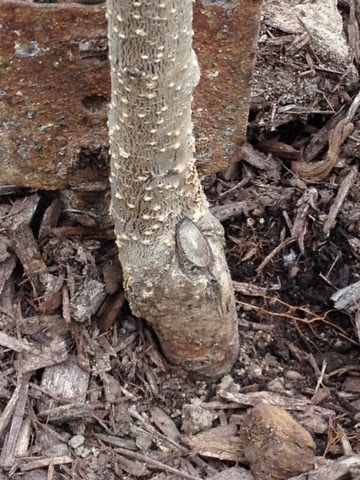Graft Union
Most modern fruit trees consist of two parts, the roostock, and the scion. The rootstock of one variety that is known to have a good, strong, vigorous root system is grafted, or joined with a variety that is known to produce exceptional fruit. The rootstock is the rooting structure of the tree, and the scion is the fruiting structure of the tree. Where these two parts meet is the graft union. Inspect the base of your fruit tree and you will find a slight bulge in the trunk with a distinct line running through it, that line is the graft union or the point at which the rootstock is united (grafted) to the scion.

The graft union should be visible above ground. If the graft union is below the surface of the soil, then chances are your tree was planted too deep. No worries, if your tree was planted too deep there is not much you can do to fix this condition. If your tree has survived its first year planted too deep, then it has probably adjusted to this non ideal situation, though your fruit tree may be at risk for other problems in the future. If you are purchasing a new fruit tree make sure the graft union is visible and that you plant your new tree at the same level as the soil found in the pot, or even better, plant a bare root tree so that you will be able to ensure that your tree is planted at the correct depth. It is better to plant your tree an inch or two high than it is to plant it too deep.
If you are unable to identify the graft union on your tree then don't be alarmed. Some older, standard sized fruit trees or fruit trees that have been grown from seed may not have a graft union because the tree was never grafted. These trees can be very healthy and vigorous without a different root stock and scion.
As mentioned above the root stock of your fruit tree is of a strong vigorous variety. At times the root stock may decide to sucker or grow water sprouts below the graft union. Because the root stock has not been bread for fruit, it is important to remove these as soon as they appear to make sure that the scion, which will produce the desired fruit, is allowed to flourish without competing, unproductive branches.
Thanks for reading! If you would like to learn more about fruit tree care and pruning, please join our Backyard Fruit Growers Facebook Group. To learn about fruit tree pruning, please take our free 9 part fruit tree pruning course.



Comments
Post a Comment